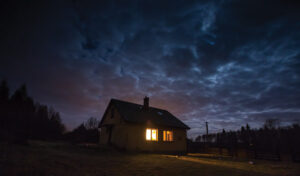Illinois’ electric cooperatives work hard to maintain equipment, monitor power delivery 24/7, and do all they can to keep the lights on. However, there are circumstances that can interfere with power delivery. Winter weather is one example. Winter storms can impact the distribution of electricity due to ice, heavy winds, sleet and other extreme conditions.
Regardless of the reason, know that when the lights go out, even during extreme weather, your co-op is doing all it can to restore power safely and efficiently.
Along with causing outages, wintery conditions can cause hiccups with power delivery that include blinking lights or ebbs and flows in the amount of power that comes into your home. Although blinking lights can be a symptom of other problems such as loose wiring connections or overloaded circuits, they can also be caused by extreme weather conditions.
Ice/freezing rain
Ice accumulation on power lines makes them heavy. One-half inch of ice can add as much as 500 pounds to a power line. This added weight can impact power distribution and even bring down a power line. Ice that forms on power lines also increases its surface area, which means gusts of wind have more to catch. The weight of ice on tree limbs can cause them to fall on power lines as well.
Wind
Wind can cause tree branches to brush power lines, resulting in blinking or flickering lights. This is why co-ops keep trees cleared around power lines and poles. In addition, heavy winds can cause lines to move and sway. If they gain enough momentum, lines can gallop or jump. This can cause disruptions in service since the extreme motion can cause lines to break or make contact with each other.
Melting ice
Melting ice can be extremely heavy, putting extra strain on power lines and causing lines to touch or rest on one another. Because of this, melting ice can cause outages even though the temperature is rising. Depending on conditions, melting can cause more problems than the ice itself.
Wind or ice + tree branches
In any weather condition, tree-related issues cause the most power outages. Branches, limbs or tree trunks can fall onto power lines and cause problems. Add wind, freezing rain or ice, and the problems increase.
Icy roads
Vehicles sliding on ice or colliding with one another can strike a power pole or pad-mounted transformer, causing an outage or other problems.
Blizzards
Heavy snowfall, icy roads or reduced visibility can make it more difficult for line crews to respond. Crews are dispatched as soon as possible to address service issues.
Be sure to have a storm preparedness kit ready before a storm strikes to help get you and your family through a power outage. Items to gather include bottled water, non-perishable food, blankets, warm clothing, hand sanitizer, first aid kit/medicine, flashlight, radio, back-up phone chargers, extra batteries and toiletries.
To learn more about preparing for storms and electrical safety, go to SafeElectricity.org.










